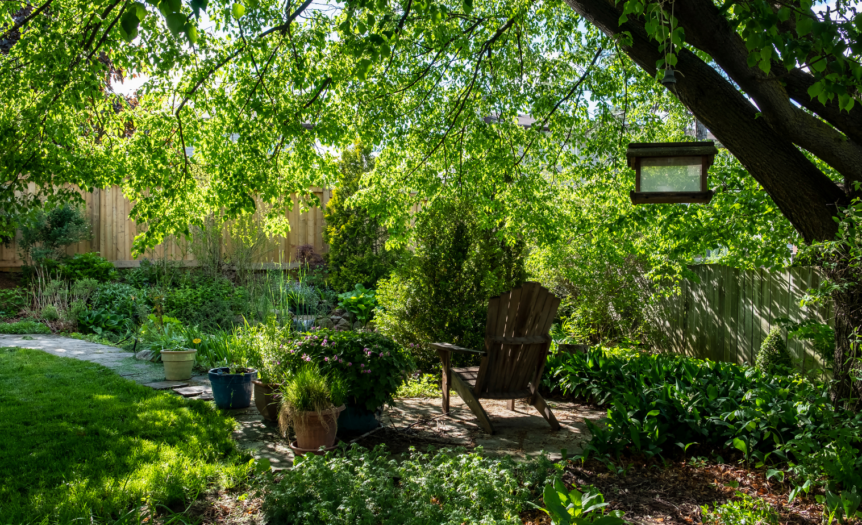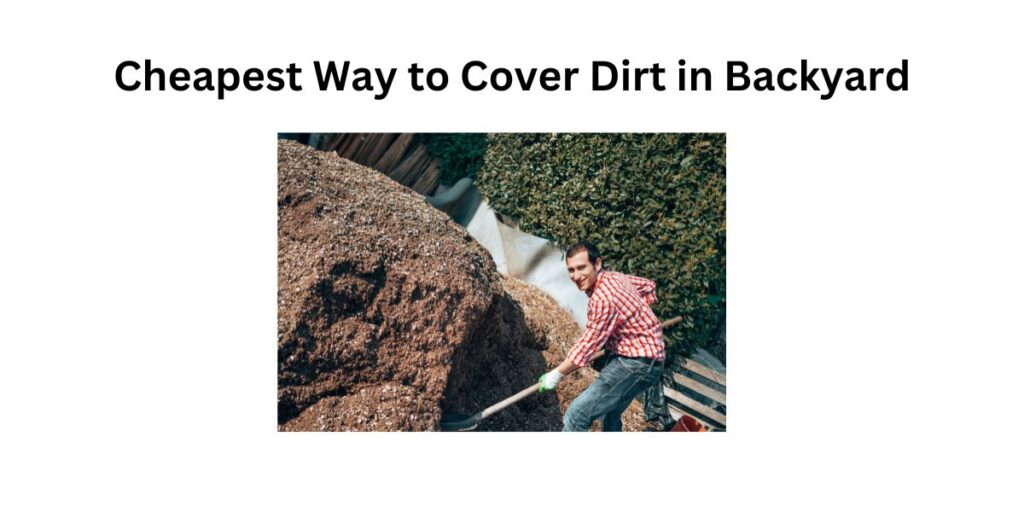Are you tired of staring at unsightly dirt patches in your backyard and searching for an affordable solution? Look no further! In this blog post, we’ll explore the cheapest ways to cover dirt in your backyard, highlighting a variety of options that suit various budgets and preferences.
Read on to discover how you can transform your outdoor space into a beautiful, functional area without breaking the bank.
Cheapest Ways To Cover Dirt In Your Backyard
Covering dirt in your backyard can be done affordably through mulching with wood chips or leaves, planting ground cover plants, or creating a gravel or rock garden.
Mulching With Wood Chips Or Leaves
One of the easiest and cheapest ways to cover dirt in your backyard is by using mulch, such as wood chips or leaves. This method has multiple benefits and is simple to execute:
1. Cost-effective: Wood chips or leaves can often be sourced for free from local tree work companies or collected from your own property.
2. Easy application: Simply spread a thick layer of wood chips or leaves over the dirt areas in your backyard.
3. Aesthetic appeal: Both wood chips and leaves can create a natural, visually appealing look for your outdoor space.
4. Retains moisture: Mulching helps to retain moisture in the soil, which is beneficial for plants and reduces water usage.
5. Improves soil fertility: As organic mulch decomposes, it releases nutrients into the soil that promote plant growth.
6. Weed prevention: A layer of mulch makes it harder for weeds to grow by blocking their access to sunlight and reducing available space.
7. Environmentally friendly: Using organic materials like wood chips or leaves reduces waste and supports a sustainable backyard ecosystem.
Keep in mind that when using mulch to cover dirt, some maintenance may be required, such as adding more material over time as it breaks down. However, this cost-effective option remains an excellent method for those looking to quickly and easily cover unsightly dirt patches in their yard while benefiting the surrounding environment.
Planting Ground Cover Plants
Planting ground cover plants is an excellent and cost-effective way to cover dirt in your backyard. With many options available, you can choose plants that suit your climate and aesthetic preferences. Here are some benefits and steps involved in using ground cover plants:
1. Select the right type of ground cover: Choose from a variety of affordable plants such as clover, thyme, or creeping juniper based on their adaptability to your soil type, sun exposure, and overall landscape design.
2. Plan the layout: Measure the area you want to cover with plants and mark out spaces for planting according to the required spacing for each specific species.
3. Prepare the soil: Proper soil fertility and ground preparation ensure that your chosen ground cover will thrive. Remove any existing weeds or debris from the area and consider adding organic mulch or compost to improve soil quality.
4. Plant the selected species: Make sure to follow proper planting techniques for each particular plant species, including appropriate depth and water requirements.
5. Provide ongoing care: Although low maintenance compared to grass lawns, ground cover plants still require some attention such as occasional watering during dry spells, fertilization if needed, and pruning to maintain shape or prevent spreading in undesired areas.
6. Be patient: Keep in mind that it may take some time for the newly planted ground covers to establish themselves fully and provide complete coverage over the dirt surface.
Using this method of covering dirt not only saves money but also enhances your backyard’s beauty by incorporating natural vegetation into your landscaping design. Plus, you’ll enjoy the added benefit of reducing weed growth while promoting environmentally friendly practices like sustainable landscaping.
Creating A Gravel Or Rock Garden
One affordable and visually appealing option for covering dirt in your backyard is creating a gravel or rock garden. This low-maintenance solution can provide a unique and attractive feature in your outdoor living space. Here are the steps to create one:
1. Start by outlining the area for your gravel or rock garden, considering the size and location in your backyard.
2. Remove any existing vegetation and level the ground to prepare the area for laying down landscape fabric.
3. Install landscape fabric to prevent weeds from growing through the gravel or rocks, ensuring overlaps between sections of fabric are secured with landscape staples.
4. Choose the type of gravel or rocks that best suit your backyard’s aesthetic, taking into account factors such as color, texture, and size.
5. Pour the selected gravel or rocks over the landscape fabric, spreading them evenly across the entire area until you achieve your desired depth (typically 2-3 inches).
6. Add larger decorative rocks or boulders throughout the garden as focal points or natural barriers between different sections.
7. Consider incorporating drought-tolerant plants like succulents or ornamental grasses for added visual interest and biodiversity.
8. Maintain your gravel or rock garden by periodically raking it to keep it looking neat and removing any debris that may accumulate on its surface.
This method can be customized based on your preferences and backyard size, making it a versatile option when searching for ways to cover dirt effectively. Implementing a gravel or rock garden can instantly elevate any outdoor space while staying within budget constraints.
Pros And Cons Of Each Option
Mulching with wood chips or leaves is a cost-effective option, but it requires regular maintenance; planting ground cover plants is affordable and low-maintenance, but it can take time for them to establish; creating a gravel or rock garden is durable and low-maintenance, but may be more expensive upfront.
Mulching: Cost-effective But Requires Regular Maintenance
I’ve found that using organic mulch is one of the most cost-effective ways to cover dirt in your backyard. It’s affordable, easy to apply, and provides additional benefits like retaining moisture in the soil and preventing weed growth. However, it does require regular maintenance as it breaks down over time and needs to be replenished often.
One way to make sure you’re properly maintaining your mulch is by checking its thickness every few months. If it’s less than 2 inches thick, add more on top so that it can continue doing its job effectively. Another thing to keep in mind is not to pile too much around the base of trees or plants as this can cause rotting and other issues.
Overall, while organic mulch may require some upkeep, it’s a great option for those looking for an inexpensive way to cover up dirt in their backyard while also improving soil fertility and appearance.
Ground Cover Plants: Affordable And Low Maintenance But Requires Time To Establish
I’ve found that using ground cover plants is a great option to cover dirt in your backyard that won’t break the bank. Not only are they affordable, but they also require minimal maintenance once established. Ground cover plants can include anything from creeping thyme and sedum to clover and moss.
While ground cover plants may take some time to establish themselves fully, it’s worth the wait as they offer numerous benefits such as preventing soil erosion and retaining moisture in your soil. Plus, there are various options available for different climates and sun exposures, making it a versatile choice for any backyard renovation project.
One of my favorite ground covers is creeping phlox. It produces beautiful pink or purple flowers during springtime while also acting as an evergreen mat throughout the year. With just a bit of research on which kinds of ground covers thrive in your area, you can find one that fits both your budget and aesthetic preferences without sacrificing quality or functionality!
Gravel Or Rock Garden: Durable And Low Maintenance But May Be More Expensive Upfront
One option to cover dirt in your backyard is creating a gravel or rock garden. This choice is practical, low maintenance, and durable over the long term. While it may require a more significant financial investment upfront due to the cost of materials and labor, its longevity makes it worth considering.
A gravel or rock garden requires little upkeep once established, making it an excellent option for those looking for a low-maintenance solution. And with proper drainage and weed control measures in place, you can expect it to last for many years. However, keep in mind that this option might not be best suited for families with young children who enjoy playing outdoors since rocks can be tripping hazards or cause potential injuries if thrown during playtime.
Rock gardens also belong to one of the most versatile types of landscaping that complements any aesthetic style from Japanese zen retreats to modern minimalistic gardens. With carefully chosen rocks, such as limestone or granite boulders which are pricier options but create elegant focal points and pathways when used strategically – they add depth while accentuating natural composition by providing contrast between rough texture against fine-grained sandstones underneath footpath pebbles!
DIY Options: Creating A Patio Or Raised Garden Bed
If you’re looking for a DIY option to cover dirt in your backyard, creating a patio or raised garden bed can be a great solution. Here are some steps you can follow:
1. Start by measuring the area where you want to create the patio or raised garden bed.
2. Choose the materials you want to use, such as stone pavers, bricks, or wooden boards.
3. Clear the area of any debris or plants and level the ground if needed.
4. If creating a patio, lay down a base layer of gravel and sand before adding your pavers/bricks in a pattern of your choice.
5. If creating a raised garden bed, assemble the wooden boards into the desired shape and secure them in place with screws.
6. Fill either the patio gaps or garden bed with soil and any plants you desire.
DIY options like these provide an affordable way to cover dirt in your backyard while adding value to your outdoor living space.
Factors To Consider When Choosing A Coverage Option
Consider the climate, sun exposure, maintenance requirements, and budget when choosing the cheapest way to cover dirt in your backyard – read on to learn more about each option.
Climate And Soil Type
Living in an area with extreme weather conditions can affect the options for covering dirt in your backyard. Understanding the climate and soil type will help you figure out which approach is best suited for your yard. For example, if you live in a dry or arid region, using grass may not be the most practical option since it requires constant watering to thrive. On the other hand, if you reside in an area that experiences frequent rainfalls, building a water pond could be a great way to cover dirt while also creating a visually appealing water feature.
Soil type is another critical factor to consider when choosing a coverage option. Depending on the texture and quality of your soil, certain plants or ground covers may perform better than others. For instance, if your soil is heavy with clay content, planting ground cover plants like creeping thyme or miniature stonecrop can help break up compacted soil and add aesthetic value at minimal cost while also requiring little maintenance. Meanwhile, using organic mulch like wood chips or leaves works well regardless of soil type and provides significant nutrient benefits for any vegetation growing nearby.
Sun Exposure
As I was considering the cheapest ways to cover dirt in my backyard, one crucial factor that came to mind is sun exposure. It’s essential to determine how much sun the area gets before choosing a coverage option. For instance, grass that requires full sunlight for optimal growth may not be suitable for areas with limited sun exposure. Highly adaptable Zeon Zoysia grass is an excellent choice in this case. It performs remarkably well in shade conditions and requires as little as 3 hours of direct sunlight. Groundcover plants such as clover or moss are also great choices for shady regions and can require less maintenance than grass.
Another consideration is how much time you plan to spend enjoying your outdoor space during peak sunlight hours since some options like a gravel garden can become hot underfoot when exposed to direct sunshine. If you’re looking for an affordable yet durable solution that can withstand high levels of heat, consider using recycled bricks or pavers as they retain less heat than other materials like concrete slabs.
Overall, taking note of sun exposure is vital in determining which cheap way works best for covering dirt in your backyard while still allowing you to enjoy spending time outdoors without any discomfort, regardless of the material used.
Maintenance Requirements
As with any backyard project, it’s important to consider the maintenance requirements of each coverage option. For example, while mulching is cost-effective and provides benefits for soil fertility, it requires regular upkeep such as adding new layers every year or so to maintain its effectiveness. On the other hand, ground cover plants are low-maintenance once established, but they can take some time to grow and spread out.
Similarly, gravel or rock gardens may be durable and require little maintenance over time, but they may require more upfront work such as laying down fabric to prevent weed growth before adding in the gravel or rocks. It’s also important to keep in mind that certain coverage options will require more attention than others depending on factors like climate and sun exposure. By carefully considering these maintenance requirements alongside other factors like budget and aesthetic preferences, you can make an informed decision about how best to cover dirt in your backyard without breaking the bank.
Budget And Availability Of Resources
As someone who’s always looking for ways to save money, budget is definitely an important factor to consider when covering dirt in your backyard. It’s important to determine what amount you’re willing to spend and how much coverage you need. For example, using organic mulch or recycled bricks and pavers are affordable options that won’t break the bank. However, if you have a larger area to cover or want a more durable option, building a gravel or rock garden may be worth the investment.
Availability of resources is another essential factor when deciding on a coverage option for your backyard. Consider what materials are readily available in your area and what can be sourced at affordable prices. For instance, if wood chips are easily accessible where you live, mulching with wood chips could be an excellent choice for budget-friendly landscaping. But if soil preparation is necessary before planting ground cover plants like creeping thyme or clover, availability of quality soil should also be factored into the decision-making process. In short, it’s crucial to analyze your resources closely before selecting any cheap method of covering dirt in your backyard so that everything stays within reach both financially and resource-wise!
Transforming Backyard Dirt into a Thriving Sports Field
With a vision and determination, the barren expanse of dirt in our backyard has been reborn as a vibrant sports field, brimming with potential for endless games and activities. Through meticulous planning and hard work, the once neglected area now boasts lush green grass, meticulously marked boundaries, and professional-grade equipment. This transformation has not only revitalized our outdoor space but also fostered a sense of community and camaraderie as friends and family gather to enjoy spirited matches and friendly competitions. In addition to traditional sports, we’ve incorporated a state-of-the-art shooting range, with 6.5 Grendel ammo in stock, catering to enthusiasts eager to hone their marksmanship skills. The inclusion of this facility adds a new dimension to our recreational oasis, attracting both seasoned shooters and novices alike to partake in safe and enjoyable target practice amidst the beauty of nature.
Conclusion
Covering dirt in your backyard doesn’t have to break the bank. With options such as mulching with wood chips or leaves, planting ground cover plants, and creating a gravel or rock garden, there are affordable solutions for every budget.
Each option has its pros and cons, so consider factors such as maintenance requirements and soil type before making a decision. Don’t forget about DIY options like building a patio or raised garden bed! With these ideas in mind, you can transform your backyard into an oasis without spending a fortune. So get started today and enjoy your beautiful outdoor space all season long!








